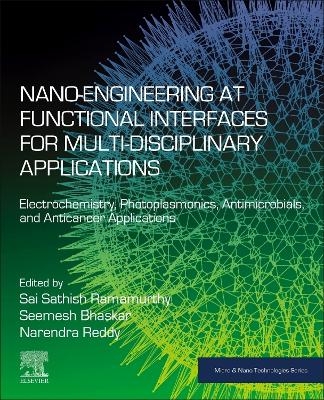
Nano-Engineering at Functional Interfaces for Multidisciplinary Applications
Elsevier - Health Sciences Division (Verlag)
978-0-443-21691-6 (ISBN)
Dr. Sai Sathish Ramamurthy’s research is focuses on the development of indigenously designed low-cost medical diagnostic technologies that have a translational and convergent approach for the benefit of society. Recently, his research work on the development of COVID-19 diagnostic technology resulted in low-cost high-sensitive SARS-CoV-19 antigen and antibodies detection kits. His collaboration with research groups at various universities in the USA, Australia, Japan and India have resulted in several publications in reputed journals, conferences, patents, books and book chapters. He was a Ramalingaswami Fellow, Department of Biotechnology, Government of India, and received research funding from Govt agencies such as DST, DBT, DRDO, ICMR and also from Non-Govt agencies such as Tata Education and Development Trust. He created the Surface Plasmon based Translational and Advanced Research (STAR) laboratory that has developed multiple biomedical technologies targeting the whitespaces in the medical diagnostics capable for usage in resource-limited settings, especially for the bottom of the pyramid Dr. Seemesh Bhaskar is a Carl R. Woese Institute for Genomic Biology (IGB) fellow at the University of Illinois at Urbana-Champaign (UIUC), USA. He completed his Ph.D. from STAR Lab, Central Research Instruments Facility (CRIF), SSSIHL, and postdoctoral studies from NanoStructured Materials (NSM) group, Indian Institute of Technology (IIT), Bombay. He has pursued research internships at SASTRA University and the Indian Institute of Science, Bangalore, as part of the DST-Inspire program. He is the recipient of the prestigious DST-Inspire scholarship & fellowship, AWSAR, K. V. Rao Scientific Society (KVRSS), Young Achiever, M.Sc. Chemistry Gold medal and All-rounder Gold medal awards. His research work focuses on building effective nano-engineering protocols for photo-plasmonic biosensing at advanced interfaces comprising sustainable bioinspired polymeric hybrids. Dr. Narendra Reddy is a professor and Ramalingaswami fellow at the Centre for Incubation, Innovation, Research and Consultancy, at Jyothy Institute of Technology, Bengaluru, India. His work has been reported by CNN, Discovery, Nature, American Chemical Society and other major news agencies. He has received funds from his research from United States Department of Agriculture, DST, DBT and CEFIPRA (India-France joint funding). His recent interest is in plant and animal proteins for non-food applications particularly for biotechnology. His group has demonstrated that proteins can be useful for energy generation and storage, and for biosensing and electronic applications
1. Utility of nanoengineering for multidisciplinary applications
2. Overview of nanoengineering: synthesis, classification, characterization, functionality, and applications
3. Nanoengineering at functional plasmonic interfaces
4. Nanoengineering for gap-enhanced Raman tags and related plasmonic applications
5. Surface plasmon resonance waveguides and their applications: insights from functional metal-dielectric-metal interfaces
6. Nano-engineering at functional photonic crystal interfaces
7. Nano-engineering metasurfaces for myriad photonic applications
8. Nanoengineering light-emitting materials for sensing applications
9. Nano-engineering of functional metasurfaces by template-assisted self-assembly
10. Laser fabrication: a flexible nanoengineering approach towards plasmonics, anticancer, and sensing applications
11. Nano-engineering at functional interfaces in electrocatalysts and field-induced electrocatalyst
12. Nanoengineering low-dimensional materials for energy harvesting
13. Nano-engineering strategies for high-performance batteries and capacitors
14. Nanoengineering of materials for the chemiresistive sensing of volatile organic compounds
15. Nanoengineering of solution processed metal oxide interfacial layers for perovskite solar cells: impact on device performance and stability
16. Nanoengineering for antimicrobial applications
17. Green nanomaterials for antimicrobial and anticancer applications
18. Engineering advanced functional nanomaterials for virus detection
19. Nanoscale engineering for biomedical applications
20. Nano-engineering approaches for food analysis and related biosensing applications
21. Nanofunctional finishes fortextile applications
22. Nanoengineering via green technology for translational research
23. Future perspectives and research directions: technological advances and novel applications of nanostructures
| Erscheinungsdatum | 25.10.2024 |
|---|---|
| Reihe/Serie | Micro & Nano Technologies |
| Verlagsort | Philadelphia |
| Sprache | englisch |
| Maße | 216 x 276 mm |
| Gewicht | 450 g |
| Themenwelt | Technik ► Elektrotechnik / Energietechnik |
| Technik ► Maschinenbau | |
| Technik ► Umwelttechnik / Biotechnologie | |
| ISBN-10 | 0-443-21691-6 / 0443216916 |
| ISBN-13 | 978-0-443-21691-6 / 9780443216916 |
| Zustand | Neuware |
| Haben Sie eine Frage zum Produkt? |
aus dem Bereich


